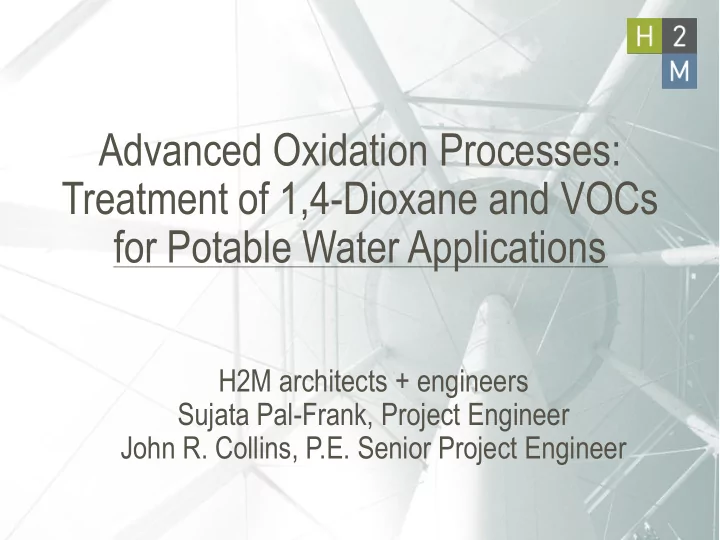

Advanced Oxidation Processes: Treatment of 1,4-Dioxane and VOCs for Potable Water Applications H2M architects + engineers Sujata Pal-Frank, Project Engineer John R. Collins, P.E. Senior Project Engineer
Outline • Project Background • 1,4-Dioxane • Advanced Oxidation Processes (AOPs) • Water Quality Considerations • Pilot Study & Results
Project Background Potable water supply well • Water Quality: • Tetrachloroethylene 1,1,1 Trichloroethane 1,4-Dioxane Trichloroethylene 1,1-Dichloroethane cis 1,2-Dichloroethylene Freon 10 & 12 Wellhead Treatments Considered: • 3 water suppliers Max: 4.4 m g/L AST • GAC • AOP • 13 water suppliers Max: 33 m g/L
1,4-Dioxane • Stabilizer for chlorinated solvents • Wastewater discharge, spills, leaks • Common household products 2,000 ug/l to 300,000 ug/l • • Manufactured Food Additives • Probable Human Carcinogen (Group B2) • Persistent in the environment • Highly soluble
1,4-Dioxane Regulations • EPA Contaminant Candidate List (CCL3) Indicates potential for regulation under SDWA • • EPA IRIS: 0.35 m g/l in drinking water • NYS UOC MCL: 50 m g/L • UCMR3: 70% of NYSMCL on Long Island
Treatment Options Considered • Air Stripping Low volatility in water • • Granular Activated Carbon • Hydrophilic • Advanced Oxidation Processes (AOPs)
Advanced Oxidation Processes Removal of organic materials Oxidation Species Oxidation Power from water by oxidation using [V] hydroxyl radicals Fluorine 3.03 Hydroxyl Radical 2.80 Characteristics • Atomic Oxygen 2.42 Strong oxidant • Positively charged 2.35 Highly reactive • TiO2 Production Methods: • Ozone 2.07 Hydrogen Peroxide 1.77 • Ozone + Hydrogen Peroxide Permanganate 1.67 Hypochlorous Acid 1.49 UV + Titanium Dioxide • Chlorine 1.36 UV + Hydrogen Peroxide • Iodine 0.54 UV + Chlorine •
Advanced Oxidation Processes Three Steps 1. Form Oxidant 2. Attack target compound 3. Mineralization
Oxidation
Oxidation
Water Quality Considerations • pH & Photolysis Hypochlorous Acid v Hypochlorite Ions • HOCI & OCI- HOCI OCI -
Water Quality Considerations • pH & Alkalinity - Scavengers Carbonates (CO 3 2- ) pH > 9 • Bicarbonates (CO 3 - ) pH 7-8 • Carbonic Acid (H 2 CO 3 ) pH < 6 • • TOC – Scavengers • Nitrate & Nitrite - Scavengers • Turbidity & TSS – UV Transmittance (%UVT)
Pilot Study • Partner: Calgon Carbon Corporation • Study: UV Oxidation with Chlorine (Calcium Hypochlorite) to confirm removal efficiency of: 1,4 Dioxane & VOCs • Estimated requirements for full scale system •
Sample Raw Water Quality • pH Slightly elevated for complete hypochlorous acid • (6.11 vs 5) Slightly elevated alkalinity (Total Alkalinity: 6 to 7 vs <6) • • TOC : Less than 1 mg/l • Nitrate & Nitrite: Nitrite <0.25 mg/l, typical • Turbidity & TSS: Low as indicated by high UVT
Pilot Unit – Batch Design Test • Pilot Unit: 1 kW high intensity MP • mercury vapor lamp • MP lamps give more light in 200 nm – 260 nm 10 gallon cylindrical • stainless steel reactor Air actuated transmittance • controller (quartz cleaner) Mixer - Chlorine • Steel shutter – UV Dosage •
Pilot Procedure 1. Add 30 liters of water sample to unit 2. Ignite UV lamp with shutter closed 3. Dose water with chlorine and mix 4. Open shutter for fixed period of time (UV Dose) 5. Close shutter, take sample, increase UV Dose 6. Repeat steps 4 and 5 When residual chlorine measured <0.5, ppm additional • chlorine was added for a target ~1 ppm residual
Test Results – Run 1 UV Dose Chlorine 1,4-Dioxane Sample No. (kWh/1,000 pH (ppm) (ppb) gal) Raw 0.00 5.82 0.00 37.0 1-0 0.00 6.19 3.80 37.0 1-1 0.60 6.62 2.66 11.0 1-2 1.19 6.12 1.82 2.40 1-3 2.38 6.09 0.60 0.12 1-4 4.76 6.18 0.00 <0.07 Chlorine 1.35 1-5 9.52 6.43 0.00 <0.07
Test Results – Run 2 UV Dose Chlorine 1,4-Dioxane Sample No. (kWh/1,000 pH (ppm) (ppb) gal) Raw 0.00 5.77 0.00 38.0 1-0 0.00 6.33 6.75 36.0 1-1 0.60 6.24 5.25 13.0 1-2 1.19 6.26 3.60 3.80 1-3 1.90 6.24 2.40 1.00 1-4 3.93 6.22 0.34 <0.07 Chlorine 1.90 1-5 7.14 6.32 0.00 <0.07
Test Results 1,4-Dioxane Initial Chlorine Max UV Dose Test Run pH Concentration (kWh/1,000gal) [ppm] 1 6.11 3.80 9.52 2 6.11 6.75 7.14
Test Results Compound 1-0 ppb 1-5 ppb 2-0 ppb 2-5 ppb 1,1-DCE 8.36 <0.50 7.78 <0.50 Cis 1,2-DCE 8.13 <0.50 7.84 <0.50 PCE 3.21 <0.50 3.00 <0.50 TCE 11.7 <0.50 11.3 <0.50 Benzene 0.69 <0.50 0.69 <0.50 1,1,1-TCA 2.07 0.54 2.1 0.77 1,1-DCA 17.9 3.78 17.5 5.29 Carbon Tetrachloride 1.69 <0.50 1.59 0.56 Bromodichloromethane <0.50 <0.50 <0.50 0.72 Chloroform <0.50 <0.50 <0.50 0.55
Test Results Organic Rate Constant Molecule [mol/L-sec] 10 9 to 10 11 Chlorinated alkenes Phenols 10 9 to 10 10 10 8 to 10 10 N-containing organics 10 8 to 10 10 Aromatics 10 9 to 10 10 Ketones 10 8 to 10 9 Alcohols 10 6 to 10 9 Alkanes
Full Scale Operation 1,400 GPM @ 2,200 hrs • • Two Calgon Sentinel TM Reactors Nine 10 kW lamps •
Capital Cost Considerations • Process Treatment Well Rehabilitation • AOP Reactor - $200,000/reactor • Chlorine Bulk Storage System - $80,000 • AST • GAC • • Buildings/Structure • Electrical MCC, Telemetry, Security • • Primary Service • Site Work
O&M Cost Considerations Electrical Loads • Building & Heating Demands (3 systems) • • GAC Replacement Costs Monitoring & Laboratory Costs • Chemical Costs • • Chlorine – Oxidation • Chlorine – Disinfection • Sodium Hydroxide – pH Adjustment
Considerations/Concerns • Incomplete reactions • Formation of unknown compounds • Raw Water Quality Considerations • Cost
Acknowledgements Calgon Carbon Corporation
Thank You
Recommend
More recommend